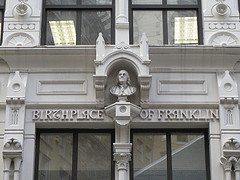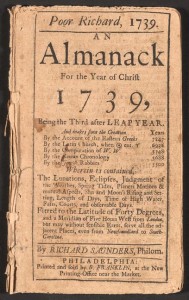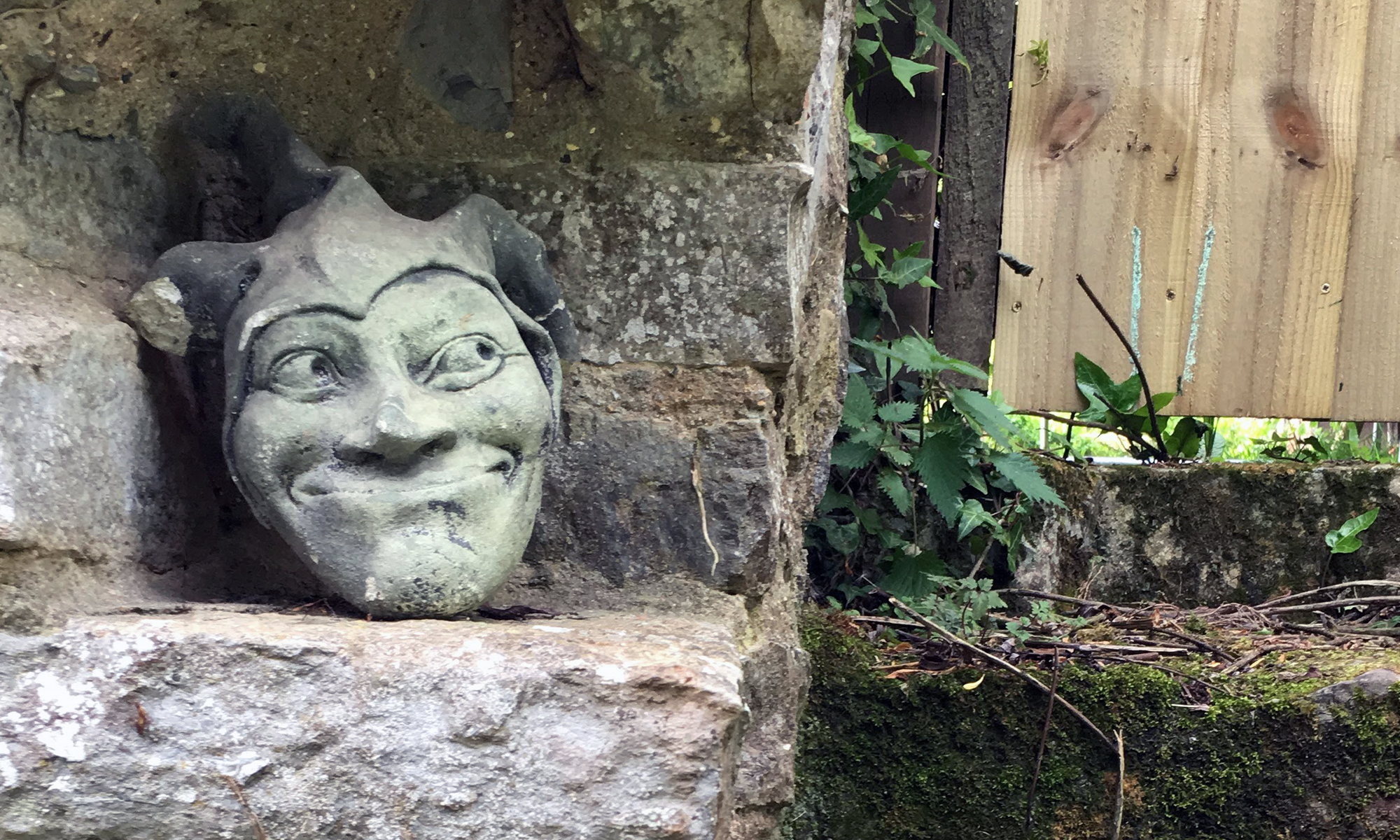(05.26.2012)
Bonnie and I have been commissioned by the chef-owner of a new 5-star restaurant to design and print his first menus. Chef is stern and a man of high standards.
We send the menus out twice for printing and laminating. Each time they come back with a wide golden border (like old National Geographic magazines) that conceals some of the copy. The lamination is just a sleeve; I can peel it back and remove the menu. So I see that the gold border, which I did not request, is printed on the plastic lamination, not on the paper menu. I wonder out loud to Bonnie, “Do you think these really need to be laminated?” But we are both resigned to the fact that, in order to withstand moisture and the handling menus undergo at restaurants, we will need to find a new laminating company that can do the job properly.
We head to the atrium of the building that houses the restaurant. It’s a tall old structure with an open, inner courtyard the entire height of the building. Like a square silo. The offices hug the perimeter of the atrium. We find the building management company and ask for a list of tenants to determine if any of them can laminate our menus. We get our list and begin walking along the edge of the atrium, spiraling upward, floor by floor.
The dream shifts. Bonnie and I are outside, in a beautiful village nestled in green, grassy, rolling hills. I tell her Chris and I are shopping for a property in the country, preferably one with some outbuildings that can be converted to studio space, maybe from an old chicken coop.
She says she has an appointment with a mentor (somehow I know the mentor is male) so the dream shifts again and we head back inside, into a large building. The same “square silo”? We enter a busy hall where there are hundreds of people. One man stands near the edge of an archway that opens into a larger room. He eyes me. His clothes are not from this century. He looks like Ben Franklin without the spectacles or the paunch. His hair is long, thin and silver-white. Poor Richard. His gaze is direct and severe—there’s no mistaking that he wants my attention.
But Bonnie is in a hurry to see her mentor, so we rush past Ben. I ask Bonnie, “What is it about practicing law that makes some go mad?” She replies it is the years of seeing people punished, the lives that are ruined. Perhaps I am thinking of Franklin as a framer of The Constitution; Poor Richard is his philosopher and printer guise.
We enter the greater hall. Just around the corner is a row of tiny, private cubicles. The first one is where Bonnie has scheduled the meeting with her mentor, who has yet to arrive. We go inside and I am disturbed by the intimacy of the space. It’s like a sex booth. I ask if I can see the postcards Bonnie brought for her meeting. She spreads them out on a small bench inside the room. They are illustrated on one side, and laminated. I pick up one that I think I recognize. “Oh, Shoko Teruyama,” I say, believing that the drawing on the card is by an artist I collect. She frowns at me and says no, the drawing is by an artist whose name I don’t remember. Maybe a Russian name. I remove the card from the laminated pocket; there are drops of water and grains of sand inside the plastic.
Then I notice that my legs and feet are bare and covered with beach sand. I don’t want to shame Bonnie in front of her mentor so I wander away to inspect the Great Hall. There I see a quotation, framed high up on the wall: someone is confessing his first big dream, which is to meet a philosopher whose name I don’t know. The opportunity to meet the philosopher comes at an anti-war rally in the 60s.
I am very curious about this. I turn left, to face the adjacent wall. High up on that wall is a bas-relief sculpture (like the head of a coin) of Richard W. from IASD. I ask him about the dream. He turns his head out of the wall to look directly at me, which is shocking. His energy is wildly electrical. He has long and wispy hair like Ben Franklin’s but it is coiled at each ear, in the style of a traditional Hopi woman: spirals, vortices of fine silver hair. He explains how he met the philosopher when he was a very young man. That meeting set Richard on his life’s course.
Day notes:
Sabine Lucas is convinced that Franklin is one of my past lives. She is a master dowser: she held a pendulum over two signatures, mine and a copy of Franklin’s from The Declaration of Independence, to test the energy between them. When she presented this idea to me I felt overwhelmed and burst into tears. It felt like being told I had been Leonardo DaVinci in a past life.
I brought a packet of “Bens” (hundred dollar bills) with me to Santa Fe because I wanted to pay Sabine in cash.
Post-dream research reveals that the building at the site of Franklin’s birth, on Milk Street in Boston, has a sculpture high up on the outer wall, very similar to my dream image. The building is quite tall, with a square footprint. Franklin is postioned under an arch, also like my dream. Appropriately, the ground floor of the building houses a Sir Speedy printer.

Photo credit and license:
https://www.flickr.com/photos/dippy_duck/4003771421/
https://creativecommons.org/licenses/by-nc/2.0/legalcode
I had this dream in 2012. At the 2014 IASD dream conference in Berkeley, Bonnie led a workshop that included printing photographic images and mounting them on card stock. She received much support from Dr. Robert Hoss, and later Robert Waggoner. At the same conference, I was sexually harassed in the art gallery by a man from Oakland. Our hotel was on the beach, on San Francisco Bay. Richard W. lives in San Francisco. In the fall of 2012 I attended a workshop at Santa Fe Clay by the sculptor Debra Fritts. She and her husband had recently purchased property in Abiquiu, New Mexico, converting a chicken coop on the site into a clay studio and workshop space.
I go to Santa Fe and San Francisco/Berkeley to explore dream space. My portal to Boston and Ben.
I am beginning to notice that when important dream figures appear I often describe them as “stern” or “severe.” Is that a misperception on my part? Perhaps a better description is “powerful.” Perhaps I am expressing a certain amount of fear of the multidimensional and shamanic levels.
From Franklin’s speech to the Constitutional Convention, considered a masterpiece: “In these sentiments, Sir, I agree to this Constitution with all its faults, if they are such; because I think a general Government necessary for us, and there is no form of Government but what may be a blessing to the people if well administered, and believe farther that this is likely to be well administered for a course of years, and can only end in Despotism, as other forms have done before it, when the people shall become so corrupted as to need despotic Government, being incapable of any other. I doubt too whether any other Convention we can obtain, may be able to make a better Constitution. For when you assemble a number of men to have the advantage of their joint wisdom, you inevitably assemble with those men, all their prejudices, their passions, their errors of opinion, their local interests, and their selfish views.”
Is the bas-relief Richard W. or Poor Richard? Does the plaque refer to 1960, or to 1760? The Hopi hair whorls are interesting in light of my two recent dreams of Pueblo Indian past lives. Why five stars?
The dream begins with the very mundane process of designing a commercial print piece, much like Franklin’s own life story. The tight border on the menu is reminiscent of the border Franklin used on “Poor Richard’s Almanack.” Lamination: a clear covering. I am uncovering content, information that is visible but protected. A constitution is a menu of laws: society does pick and choose over the course of time which of those laws are enforced and which are ignored or ammended.


I love being in your dreams!! That is great to go and retrieve this dream about Poor Richard after being told he was one of your past lives. And also the thing about the hair like the Hopi woman. It is like they are both making an appearance. very cool